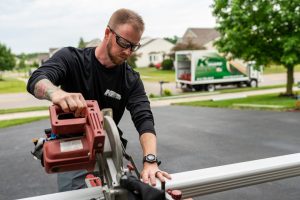 Personal preference or comfort. Aesthetics and curb appeal. Improving functionality and minimizing maintenance. Improving safety.
Personal preference or comfort. Aesthetics and curb appeal. Improving functionality and minimizing maintenance. Improving safety.
There are a variety of reasons why property owners may elect to carry out home improvement projects, and one such project that checks all of the aforementioned boxes is installing gutter guards on your property. Gutter guards work by preventing the likes of leaves, twigs and other debris from entering your gutter system, while still allowing water to enter it, flow freely to the downspouts, and discharge safely away from your property.
The bottom line is that there are a lot of reasons why this home improvement project makes sense. In this post, we’ll discuss the return on investment and peace of mind that you can achieve from investing in your gutters. Here’s a look:
Top Benefits of Gutter Guards
One of the reasons why gutter guards are such an ideal home improvement project is because of all the benefits they offer following installation. Here’s a summary of some of them:
Preventing Property Damage
Chances are you take your gutters for granted. They’re installed on your fascia and you always trust that they’re doing the job that they’re supposed to be doing, which is catching water runoff from the roof and depositing it safely away from your foundation. Unfortunately, many property owners don’t take the time to properly clean their gutters – and gutter cleaning can be even more demanding in areas of dense foliage.
When leaves, twigs and other debris accumulate in the gutters, it can lead to property damage in a few ways. For instance:
- It can clog downspouts, which causes water to pool up in the gutter and spill over onto the ground directly below it. This can lead to foundation degradation and water intrusion on lower levels of the property.
- Clogged gutters and downspouts can also pose an issue in the winter months when snowmelt is unable to drain properly. This can lead to the formation of ice dams near the roofline, which could cause water to seep underneath the roofline and into the attics or ceilings of a property.
- When debris accumulates in gutters, it can put excessive weight on the gutter system. When weight builds up, it can cause the gutters to pull away from the fascia and the property’s roofline. This can lead to a gap between the roofline and the gutter, and as a result, water can spill down in between this gap. It can lead to foundation degradation on the ground level and fascia damage and repair near the roofline. Additionally, it can also lead to gutter damage and the need to replace gutters prematurely.
- When you’re starting a campfire, you’re likely using twigs, leaves and other forest debris to help build the fire. And being that these are also what you’re likely to see in clogged gutters, it could cause a home fire to spread more rapidly should such an event impact your home. Clear gutters won’t accelerate spread as quickly.
- Lastly, gutter guards can also prevent pest infestations in your gutter system. When debris builds up in your gutter system, it can be an invitation for insects, rodents and even birds to build nests. Pests have the potential to cause significant damage to your gutter system and even the surrounding exterior of your home. In some parts of the country, we’ve even seen snakes slither up downspouts looking for meals in gutter systems where rodents have made nests.
Reducing Maintenance
Gutter guards are great because they essentially eliminate any need to clean your property’s gutters. For those without gutter guards, it’s recommended that gutters are cleaned at least twice a year – once in the spring and again in the fall. For those that live in areas of dense foliage, more frequent cleanings are often necessary.
When gutter guards are installed, leaves and debris will simply roll off the top of the guard and onto the ground below. Yet water will be able to enter and flow freely through the system.
With gutter guards, you won’t have to worry about remembering to clean out the gutters. And you can keep the ladder in the tool shed. Think of the gutter guard as the component that will do the maintenance for you.
More Attractive for Potential Buyers
If you’re ever looking to sell a home, gutter guards can offer a nice competitive advantage over similar homes that are on the market. This is likely to be due to a few key reasons:
- As we noted earlier, gutter guards eliminate the crucial chore of cleaning out your gutters and downspouts on the regular. This can be especially attractive for older buyers or buyers who are afraid of heights or weary of the safety issues that come with working on ladders at heights.
- Gutter guards can also show a potential buyer that you’ve been serious about maintaining your home. Since gutter guards are a key way to ensure gutter systems are working properly and help to avoid the potential for water damage and foundation issues, a gutter guard system can help a buyer gain a favorable perception of the seller and the overall condition of the property.
Contact KGuard Today
For more information on the benefits of gutter guards and why they make the ideal home improvement project, contact us at KGuard today or visit our website to find a distributor near you.
This post first appeared on https://www.kguard.com